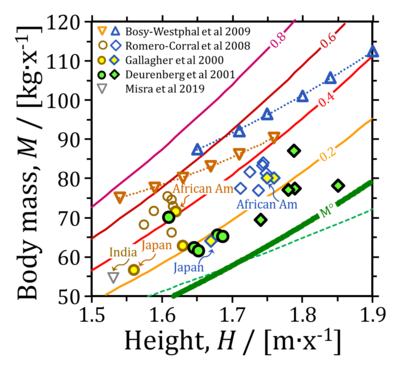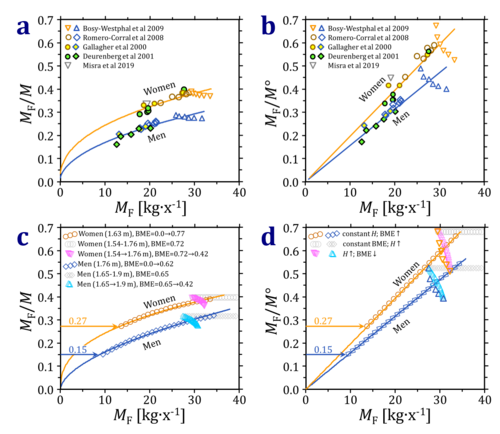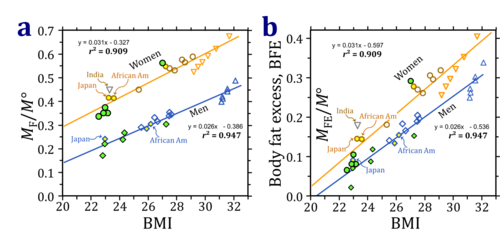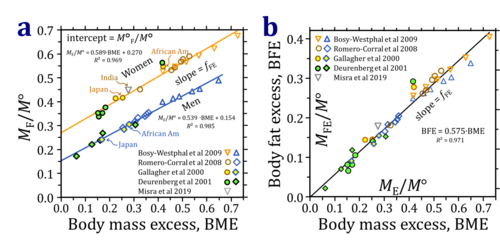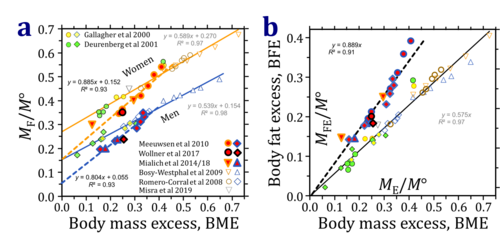Description
[[Description::Body fat is conventionally expressed as BF%, which is the percentage of body fat mass relative to the total body mass. In the healthy reference population (HRP), there is zero body fat excess, and the fraction of excess body fat in the HRP is expressed - by definition - relative to the reference body mass, M°, at any given height. Although M° is identical in females and males at any given height, the fraction of body fat is higher in females than males in the HRP, hence it is reasonable that the body fat excess, BFE, - but not BF% - represents the common risk factor and indicator of obesity. Importantly, body fat excess and body mass excess, BME, are linearly related, which is not the case for the body mass index, BMI.]]
Abbreviation: Has abbr::BFE
Reference: [[Info::Body mass excess]]
Work in progress by Gnaiger E 2020-01-15 linked to a preprint in preparation on body mass excess, BME. Note: BME is now defined as ΔM/M° = (M-M°)/M° = M/M°-1, in contrast to our previous definition as M/M°.
From BMI to BME
- The BMI is known to predict adiposity with limited accuracy, with poor correlations between BMI and percentage of body fat. Several attempts have been made to derive alternative anthropometric indexes. The body adiposity index (Bergman et al 2011), however, has been criticized as insufficiently accurate for clinical applications (Cerqueira et al 2018). Other attempts include a shift of BMI cutoffs for different ethnic groups, adjustment of parameters for ethnicity, sex and age in equations incorporating the BMI, or the BMI is replaced and height/waist circumference included in fitted algorithms (Gallagher et al 2000; Al-Gindan et al 2015; Woolcott, Bergman 2018). The body mass excess, BME, introduces a concept that does not consider whole-body fat percentage, BF%, as the relevant risk factor, but the excess body fat mass, MFE, is emphasized with respect to the healthy reference body mass and composition, empirically based on the allometry of the healthy reference population, HRP.
From BF% to body fat excess, BFE
- The BME is the excess body mass of an individual, ΔM = M-M° [kg/x], normalized for the reference body mass, M° [kg/x], BME = ΔM/M°. M° is calculated at a given height, H [m], from the allometric height-body mass relationship of the healthy reference population, HRP.
- BF% expresses body fat mass, MF [kg/x], as a percentage of total body mass (Gallagher et al 2000; Deurenberg et al 2001; Romero-Corral et al 2008; Bosy-Westphal et al 2009),
BF% = 100*MF/M (Eq. 1)
- MF increases due to accumulation of fat mass. Note that at any given height BF% or MF/M = BF%/100 increases non-linearly with attenuated slope as a function of MF (Fig. 1a). In contrast, normalization for M° - the reference body mass without excess fat mass - yields linear and proportional functions at constant height, since M° is a constant at any height (Fig. 1b).
- Figure 1: Model calculation on body fat mass, MF, normalized for (a) total body mass, M, and (b) reference body mass, M°. The relationship for women and men is shown at constant height of 1.63 m and 1.76 m, with M° = of 51.2 and 63.8 kg/x. From BME= 0.0 to 0.7, M increases 1.7-fold to 87.2 and 108.8 kg per woman or man, respectively. The reference body fat mass fraction is estimated at 0.27 and 0.15 for women and men (horizontal full arrows), increasing to MF/M = 0.39 and 0.32, respectively (a: vertical dotted arrows). This covers the range of BME from 0.0 to 0.7 equally in women and men. Due to the 'weight-lifting effect', there is an excess lean mass, MLE, which is assumed to be 0.8 times the excess fat mass, MLE = 0.8·MFE. At the same BME, the net increase or body fat excess, BFE = ΔMF/M°, is 0.39, identical in women and men (b: vertical dotted arrows).
Impact of experimental design
- Variation of body mass plotted as a function of height combines two determinants: (1) the allometric function in the healthy reference population, HRP, at zero body fat excess (M°), and (2) excess body mass (BME). The allometric exponent, HA, is A=2.89 in the range of heights covered in Fig. 2. An exponent of 2 is implied in the body mass index, BMI = M/H2. Allometric exponents in populations deviating from the HRP must be interpreted with care (Fig. 2; dotted lines for a study of females and malesof different heights), since the shift to overweight and obesity may affect subpopulations of different heights to different degrees (Bosy-Westphal et al 2009). Asian populations tend toward lower adult heights.
- Figure 2: Variation of body mass, M, as a function of height. M at identical BME is indicated by full lines (M° at BME=0.0; M at BME=0.2 to 0.8; equivalent to M=1.2M° to 1.8M°). The green dashed line indicates the allometric relation assumed in the definition of the BMI (exponent of 2, which is significantly lower then the exponent of 2.86 in the HRP). Dotted lines for females and males (data of Bosy-Westphal et al 2009). African American females are on average obese (BME>0.4), compared to African American males who are overweight (BME>0.2), whereas Japanese females and males are both close to the allometric overweight line (data of Gallagher et al 2000). Symbols not indicated by arrows are American or European Caucasian whites.
- Figure 3: Normalized body fat mass as a function total fat mass, MF. (a and b): Populations shown in Fig. 2. (c and d): Model calculations comparing strategies of selecting different groups. Body fat normalized for (a, c) total body mass, M, and (b, d) reference body mass, M°. Model 1: see Fig. 1 for increasing BME at constant height, H. Model 2: constant BME at increasing H. Model 3: from the study design of Bosy-Westphal et al 2009, when an increase in H is associated with a linear decrease in BME. The bold triangles depict the non-linear decrease in BME at the heights in the experimental data set. The excess lean mass, MLE, is assumed to be 0.8 times the exccess fat mass, MFE. See text for further explanations of the model calculations.
- As expected, the relationship between normalized fat mass and total fat mass is complicated in real data (Fig. 3a and 3b) compared to the simple model of constant height (Fig. 1). In agreement with the model in Fig. 1, however, normalization of body fat for the reference body mass, M°, yields a steeper slope and hence higher sensitivity (Fig. 3a and 3b).
- Taken together, two strategies are suggested by the above analyses for presenting the relative body fat excess, BFE: (1) normalization by the reference body mass, M°, and (2) subtraction of the refernce body fat mass, MF-MF° (Fig. 1b). These two steps improve the relation between BFE and BMI (Fig. 4).
- Figure 4: Body fat mass correlated with BMI. (a) Total body fat mass, MF/M°, and (b) body fat excess, BFE = (MF-MF°)/M°. Asian populations tend to have higher fat mass at the same BMI, although there is a similarly large variability within Caucasian populations. Women have a higher relative fat mass at the same BMI compared to men. This difference is still apparent in the BFE. See Fig. 2 and 3 for further explanation of symbols.
- The purported differences between Asian and non-Asien populations is based on BMI (Fig. 4), ignoring the effect of height on BMI. In contrast, BME provides a unifying concept for ethnic groups of different evolutionary backgroud, with differences in body height as a key to normalize for appropriate reference body mass, M° (Fig. 5). Althoug M° at any given height is identical in women and men, a well defined difference exists in the reference body fat fraction between women and men, independent of height and evolutionary background of the populations covered in the original publications (Fig. 5a). Thus the large scatter implicated in using the BMI as an indicator or obesity (Fig. 4) is significantly reduced on the basis of the BME concept related to the healthy reference population. Body fat excess, BFE, is linearly related to body mass excess, BME (Fig. 5).
- Figure 5: Body mass excess, BME, as an indicator of (a) total body fat mass, MF/M°, and (b) body fat excess, BFE = (MF-MF°)/M°. R2 is 0.969 and 0.985 for women and men, respectively. The intercept at BME=0 is the relative body fat mass of the healthy reference population. This is 0.27 for women and 0.15 for men. The linear slopes are not significantly different in women and men, at 0.59 and 0.54, respectively. The average slope implies that an average fraction of 0.44 of the excess body mass is due to a gain of lean body mass with increasing BME, and a fraction of 0.66 is due to a gain of fat mass. Data were calculated from tabulated values in the original references, including European and American Caucasian populations, African Americans, Japanese and Asien Indian populations as indicated.
- For generalization, a detailed forcus is required on the different methods used for measurement of body fat. The data of Gallagher et al (2000) and Deurenberg et al (2001) are based on duel-energ X-ray absorptiometry (DXA). Romero-Corral et al (2008) and Bosy-Westphal et al (2009) describe in detail their method with body impedance analysis (see also Misra et al 2019). These studies use highly controlled samples with well-defined exclusion criteria. This is not the case for the self-selected sample used in the analyses of Meeuwsen et al (2010), and for the study of Mialich et al (2018), which included students, employees, patients and/or accompanying persons of a hospital (see also Mialich et al 2014). The latter studies were excluded in the analysis represented in Fig. 5, and are shown for comparison in Fig. 6. The further discussion is restricted to Fig. 5, and additional expert evaluation is required to resolve the discrepancies shown in Fig. 6.
- Figure 6: Body mass excess, BME, as an indicator of (a) total body fat mass, MF/M°, and (b) body fat excess, BFE = (MF-MF°)/M°, in two groups of data sources. Data of Fig. 5 are shown in small symbols. Added symbols (red filling) are based on bioelectrical impedance analysis, like the open symbols in Fig. 5 (and Fig. 6). The linear slopes in the two data sets are significantly different, but in each case identical in women and men, at 0.88 and 0.80, respectively, in the added data set, which includes ethnically mixed populations (UK: Meeuwsen et al 2010; Brazil: Wollner et al 2017; Mialich et al 2014, 2018).
MitoPedia: BME
References
- Al-Gindan YY, Hankey CR, Govan L, Gallagher D, Heymsfield SB, Lean ME (2015) Derivation and validation of simple anthropometric equations to predict adipose tissue mass and total fat mass with MRI as the reference method. Br J Nutr 114:1852-67. - »Bioblast link«
- Bergman RN, Stefanovski D, Buchanan TA, Sumner AE, Reynolds JC, Sebring NG, Xiang AH, Watanabe RM (2011) A better index of body adiposity. Obesity (Silver Spring) 19:1083-9. - »Bioblast link«
- Bosy-Westphal A, Plachta-Danielzik S, Dörhöfer RP, Müller MJ (2009) Short stature and obesity: positive association in adults but inverse association in children and adolescents. Br J Nutr 102:453-61. - »Bioblast link«
- Cerqueira MS, Santos CAD, Silva DAS, Amorim PRDS, Marins JCB, Franceschini SDCC (2018) Validity of the body adiposity index in predicting body fat in adults: a systematic review. Adv Nutr 9:617-24. - »Bioblast link«
- Deurenberg P, Andreoli A, Borg P, Kukkonen-Harjula K, de Lorenzo A, van Marken Lichtenbelt WD, Testolin G, Vigano R, Vollaard N (2001) The validity of predicted body fat percentage from body mass index and from impedance in samples of five European populations. Eur J Clin Nutr 55:973-9. - »Bioblast link«
- Gallagher D, Heymsfield SB, Heo M, Jebb SA, Murgatroyd PR, Sakamoto Y (2000) Healthy percentage body fat ranges: an approach for developing guidelines based on body mass index. Am J Clin Nutr 72:694-701. - »Bioblast link«
- Iwaniec UT, Turner RT (2016) Influence of body weight on bone mass, architecture and turnover. J Endocrinol 230: R115-30. - »Bioblast link«
- Meeuwsen S, Horgan GW, Elia M (2010) The relationship between BMI and percent body fat, measured by bioelectrical impedance, in a large adult sample is curvilinear and influenced by age and sex. Clin Nutr 29:560-6. - »Bioblast link«
- Mialich MS, Martinez EZ, Jordao JJ (2014) Application of body mass index adjusted for fat mass (BMIfat) obtained by bioelectrical impedance in adults. Nutr Hosp 30:417-24. - »Bioblast link«
- Mialich MS, Silva BR, Jordao AA (2018) Cutoff points of BMI for classification of nutritional status using bioelectrical impedance analysis. J Electr Bioimp 9:24-30. - »Bioblast link«
- Misra P, Singh AK, Archana S, Lohiya A, Kant S (2019) Relationship between body mass index and percentage of body fat, estimated by bio-electrical impedance among adult females in a rural community of North India: A cross-sectional study. J Postgrad Med 65:134-40. - »Bioblast link«
- Romero-Corral A, Somers VK, Sierra-Johnson J, Thomas RJ, Collazo-Clavell ML, Korinek J, Allison TG, Batsis JA, Sert-Kuniyoshi FH, Lopez-Jimenez F (2008) Accuracy of body mass index in diagnosing obesity in the adult general population. Int J Obes (Lond) 32:959-66. - »Bioblast link«
- Wollner M, Paulo Roberto BB, Alysson Roncally SC, Jurandir N, Edil LS (2017) Accuracy of the WHO's body mass index cut-off points to measure gender- and age-specific obesity in middle-aged adults living in the city of Rio de Janeiro, Brazil. J Public Health Res 6:904. - »Bioblast link«
- Woolcott OO, Bergman RN (2018) Relative fat mass (RFM) as a new estimator of whole-body fat percentage ─ A cross-sectional study in American adult individuals. Sci Rep 8:10980. - »Bioblast link«
MitoPedia concepts:
MiP concept
Labels:


